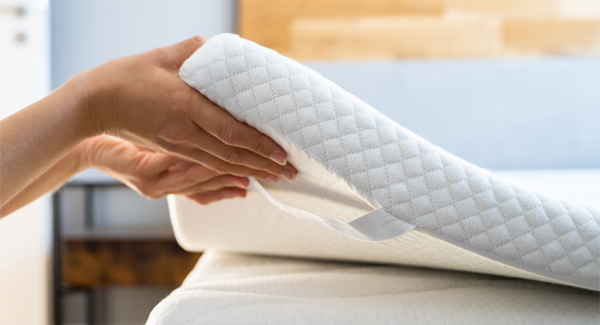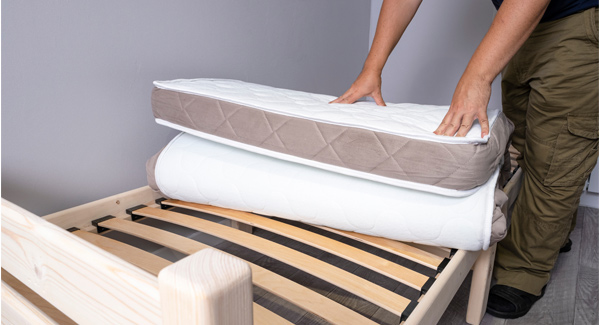Home » Bedding advice » Can You Use An Electric Blanket With A Memory Foam Mattress?
Can you use an electric blanket with a memory foam mattress?
Article navigation
- Published:
- Written by: Tony Brown
- Topic: Bedding advice
With rising energy bills, many of us are looking for cheap alternatives to keeping warm in the bedroom. Though electric blankets are a popular way to keep warm and cosy, some bed manufacturers advise against using them, especially with memory foam mattresses.
Here are some reasons to avoid using an electric blanket with a memory foam mattress and what you can do instead.
The material may become too soft from excessive heat
Memory foam is a temperature-sensitive material that provides excellent support and pressure relief. The material relies on natural body heat to conform and adapt to the shape of the body. It can feel quite firm initially but softens as the body generates heat throughout the night. The hotter the foam becomes, the more it will soften, and as a result, the body will sink deeper into the mattress. This also means the material takes longer to recover to its original shape.
If the material becomes too soft from excessive heat caused by an electric blanket, it can make it harder to turn over in bed. Some people may even feel ‘stuck’ in the mattress. This can be particularly problematic for heavier people.
Memory foam tends to feel warmer than other materials
Most memory foam mattresses have a dense cell structure. As the material tends to retain heat, this causes the body to become warmer. Though some manufacturers address this with moisture-wicking fabrics and materials, memory foam tends to feel warmer than ordinary mattresses. Therefore, in most cases, using an electric blanket is not necessary.
Sleeping on an electric blanket creates an additional layer
Sleeping on top of an electric blanket creates an additional layer between you and the mattress, reducing the material’s effectiveness in conforming closely to the body.
Skin irritations and burns
Falling asleep with the electric blanket left on can result in skin irritations and burns because the appliance rests on the same body part for an extended period.
Can you use a hot water bottle to warm up the bed?
A hot water bottle may seem like an effective way to warm up the bed. But for the same reasons as an electric blanket, you should avoid using a hot water bottle with a memory foam mattress.
A further risk with hot water bottles is that if they leak, water can stain or damage the material, which could cause irreversible damage and invalidate the mattress warranty.
How to keep warm in the bedroom without an electric blanket
There are several ways to keep warm in bed without using an electric blanket or having to crank up the heating.
Use warmer bedding
An easy and cost-effective way to keep warm in bed is to use warmer bedding. Use a thicker duvet, extra blankets, and flannel or fleece bedding to winter-proof your bedroom.
Draught-proof your home
Draught-proofing your home is an effective way to prevent cold air from coming in and warm air from escaping. But before blocking or sealing any gaps, remember that properties need ventilation to prevent dampness and condensation.
If you feel cold air coming through doors or windows, you can seal gaps with draught-proofing strips. You can also use draught excluders to cover the gaps across the bottom of doors.
Closing curtains and blinds at night can also prevent heat loss. But keep them open during the day to let warm sunlight into your home and allow fresh air to circulate.
If your bed is positioned close to a window or door where you are exposed to cold air, consider moving the bed to a warmer part of the room.
Also, consider using thick rugs, especially in bedrooms with exposed floorboards. Not only are rugs a stylish addition to the bedroom, but they also help to insulate the floors.
Tips for using electric blankets safely
Each manufacturer should provide guidance on whether their mattresses are suitable for use with an electric blanket. Here are some safety tips if you decide to use an electric blanket.
- Always follow the manufacturer’s care instructions and keep the blanket in good condition.
- Children or pregnant women should not use the appliance.
- Avoid using a second-hand electric blanket.
- Do not operate the appliance if there are visible signs of wear and tear.
- Avoid placing the electric blanket directly on top of the mattress.
- Limit its use to shorter periods, for example, to pre-warm the bed.
- If the electric blanket has temperature controls, ensure it remains on a low to medium heat setting.
- Do not operate an electric blanket with wet hands or use the appliance if it becomes wet.
- Avoid using a hot water bottle or heating pad with an electric blanket.
- Make sure the appliance is switched off when not in use.
Share this article

About the author
Tony Brown is the founder and creator of The Bed Consultant. His career in the bed industry began in 2002. After graduating from university with a degree in Business Administration, Tony joined one of the largest independent furniture retailers in the UK as a bed consultant. Tony has helped thousands of customers find the perfect mattress.





